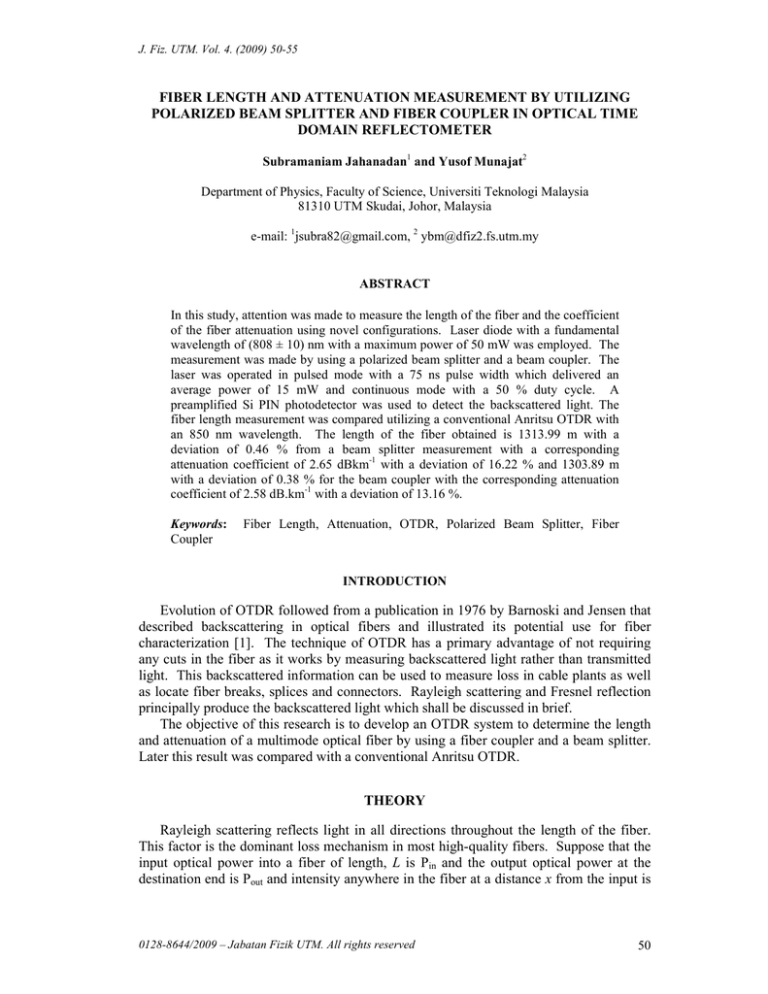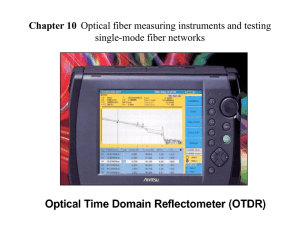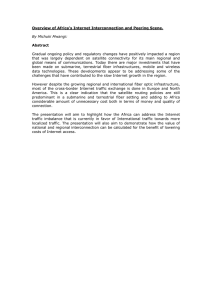
J. Fiz. UTM. Vol. 4. (2009) 50-55
FIBER LENGTH AND ATTENUATION MEASUREMENT BY UTILIZING
POLARIZED BEAM SPLITTER AND FIBER COUPLER IN OPTICAL TIME
DOMAIN REFLECTOMETER
Subramaniam Jahanadan1 and Yusof Munajat2
Department of Physics, Faculty of Science, Universiti Teknologi Malaysia
81310 UTM Skudai, Johor, Malaysia
e-mail: 1jsubra82@gmail.com, 2 ybm@dfiz2.fs.utm.my
ABSTRACT
In this study, attention was made to measure the length of the fiber and the coefficient
of the fiber attenuation using novel configurations. Laser diode with a fundamental
wavelength of (808 ± 10) nm with a maximum power of 50 mW was employed. The
measurement was made by using a polarized beam splitter and a beam coupler. The
laser was operated in pulsed mode with a 75 ns pulse width which delivered an
average power of 15 mW and continuous mode with a 50 % duty cycle. A
preamplified Si PIN photodetector was used to detect the backscattered light. The
fiber length measurement was compared utilizing a conventional Anritsu OTDR with
an 850 nm wavelength. The length of the fiber obtained is 1313.99 m with a
deviation of 0.46 % from a beam splitter measurement with a corresponding
attenuation coefficient of 2.65 dBkm-1 with a deviation of 16.22 % and 1303.89 m
with a deviation of 0.38 % for the beam coupler with the corresponding attenuation
coefficient of 2.58 dB.km-1 with a deviation of 13.16 %.
Keywords:
Coupler
Fiber Length, Attenuation, OTDR, Polarized Beam Splitter, Fiber
INTRODUCTION
Evolution of OTDR followed from a publication in 1976 by Barnoski and Jensen that
described backscattering in optical fibers and illustrated its potential use for fiber
characterization [1]. The technique of OTDR has a primary advantage of not requiring
any cuts in the fiber as it works by measuring backscattered light rather than transmitted
light. This backscattered information can be used to measure loss in cable plants as well
as locate fiber breaks, splices and connectors. Rayleigh scattering and Fresnel reflection
principally produce the backscattered light which shall be discussed in brief.
The objective of this research is to develop an OTDR system to determine the length
and attenuation of a multimode optical fiber by using a fiber coupler and a beam splitter.
Later this result was compared with a conventional Anritsu OTDR.
THEORY
Rayleigh scattering reflects light in all directions throughout the length of the fiber.
This factor is the dominant loss mechanism in most high-quality fibers. Suppose that the
input optical power into a fiber of length, L is Pin and the output optical power at the
destination end is Pout and intensity anywhere in the fiber at a distance x from the input is
0128-8644/2009 – Jabatan Fizik UTM. All rights reserved
50
J. Fiz. UTM. Vol. 4. (2009) 50-55
P. The attenuation coefficient, dB is defined as the fractional decrease in the optical
power per unit distance
dB
1 dP
P dx
(1)
We can integrate this over the length, L of the fiber to relate to Pout and Pin by
1 P
dB ln out
L Pin
(2)
We can just as well define attenuation in terms of light intensity but we have used power
to follow convention since attenuation tests on optical fibers measure the optical power.
In general, optical power attenuation in an optical fiber is expressed in terms of decibels
per unit length of fiber, typically dB per km [2]. The attenuation of the signal in decibels
per unit length is defined in terms of the logarithm to base 10 by
P
1
dB 10 log out
L
Pin
(3)
Fresnel reflection concerns about the amount of light reflection occur at a plane
boundary between two dielectrics. The reflection coefficient, r is the ratio of the reflected
electric field to the incident electric field. For normal incidence the Fresnel’s equation
simplifies into
r
n1 n 2
n1 n 2
(4)
where n1 is the refractive index in the incident region and n2 is the index in the
transmitted region. If n 2 n1 , the reflection coefficient becomes negative and this
indicates a 180° phase shift between the incident and the reflected electric fields [2, 3].
The reflectance, R is the ratio of the reflected-beam intensity to the incident-beam
intensity. Because the intensity in an optic beam is proportional to the square of its
electric field, the reflectance is equal to the square of the reflection coefficient. Thus,
n n2
R 1
n1 n 2
2
(5)
A perfect fiber end reflects about 4 percent of the power incident on it.
In addition to determination of attenuation and component losses, an OTDR also can
be used to measure length and locate breaks in an optical fiber. The fiber length, L can be
calculated from the time difference between the pulses reflected from the front and far
ends of the fiber. If this time difference is t, then the length L is given by:
ct
(6)
2n
where n is the refractive index of the fiber core. The factor 2 accounts for the round trip
made by the pulse [2].
L
0128-8644/2009 – Jabatan Fizik UTM. All rights reserved
51
J. Fiz. UTM. Vol. 4. (2009) 50-55
EXPERIMENTAL METHOD
The set up for the polarized beam splitter is shown in Figure 1, whereas the
modification setup with a fiber coupler is shown in Figure 2 [4]. For length
measurement, the controller unit is set to operate the diode laser in the pulsed mode. The
laser pulse width is 75 ns with energy of 1 nJ per pulse; the average power of the laser is
15 mW.
The control unit is set to 50 % duty cycle to operate the diode laser in continuous
mode to measure the value of attenuation coefficient. The number of photons launched
into the optical fiber was increased by increasing the current on the laser diode controller
or by enlarging the pulse length. During the phase of the switched on radiation, one fills
the fibers with photons which produces the scattering light at the Rayleigh scattering
centers which is directed towards the fiber entrance. The switching off the light pulse,
results in a rapid reduction of the backscattering light produced at the fiber entrance
surface.
Figure 1: Schematic diagram of experimental set up with a polarized beam splitter.
Si PIN
Photodiode with
Amplifier
Test Fiber
Fusion
Splicing
Coupler
Coupling
Optics
Trigger
Si PIN
Photodiode
OSCILLOSCOPE
Beam
Collimator
Laser
Diode
Waveform Signal
Figure 2: Schematic diagram of experimental set up with an optical fiber coupler.
0128-8644/2009 – Jabatan Fizik UTM. All rights reserved
52
J. Fiz. UTM. Vol. 4. (2009) 50-55
RESULTS AND DISCUSSION
Back Scattered Signal
The fiber length measurement using a polarized beam splitter is (1314 ± 21) m,
whereas with the fiber coupler the fiber length is (1304 ± 11) m.
The typical result obtained for the measurement of the optical fiber attenuation by
using a continuous wave with a polarized beam splitter is shown in Figure 3.
Figure 3: Logarithmical division of the backscattered signal versus fiber length.
The linear part of the slope contains the loss or attenuation beam. By calculating the
gradient for selected two points on the graph yields the attenuation coefficient of, dB =
(2.65 ± 0.03) dB.km-1.
The typical result obtained for the measurement of the optical fiber attenuation by
using a continuous wave with a fiber coupler is shown in Figure 4. The total loss for the
whole system is 10.08 dB. The loss at the optical coupler is 3.05 dB and the loss at the
fusion splice is 0.25 dB. By subtracting the external loss from the system the total loss
through the fiber from the two way flows is obtained as 6.78 dB. The attenuation
coefficient dB could be determined as:
Total Loss (dB)
dB
dis tan ce(km)
(7)
From the calculation the value of the attenuation coefficient is, dB = (2.58 ± 0.02)
dB.km-1.
0128-8644/2009 – Jabatan Fizik UTM. All rights reserved
53
J. Fiz. UTM. Vol. 4. (2009) 50-55
Back Scattered Signal
1
0.1
0.01
0
200
400
600
800
1000
1200
1400
1600
1800
Fiber Length(me tre)
Figure 4: Logarithmical division of the backscattered signal versus fiber length.
The measured value of attenuation coefficient by using MEOS OTDR with a beam
splitter yields a higher value by 0.07 dB.km-1 or 2.71 % compared to optical coupler.
Whereas the average value for the MEOS OTDR is 2.62 dB.km-1. In comparison with
Anritsu OTDR the measured difference could be achieved up to 14.91 %. Thus the
attenuation coefficient measured by using Anritsu OTDR is found to be lower in
comparison to MEOS OTDR.
The measurement of fiber length by using a pulsed laser from MEOS OTDR by
utilizing a beam splitter and an optical fiber coupler yields a difference of 0.77 %. The
optical fiber length measurement by using a continuous wave from MEOS OTDR by
utilizing a beam splitter and a beam coupler yields almost the same value in comparison
with the Anritsu OTDR where the excess fiber length of 5.99 m or 0.46 % is realized.
CONCLUSION
The OTDR system has been modified by using a fiber coupler. The length and
attenuation of fiber optic were measured and compared with a conventional Anritsu
OTDR.
The multimode optical fiber length is obtained as (1313.99 ± 21.10) m with calculated
attenuation coefficient of (2.65 ± 0.03) dB.km-1 which measured using a polarized beam
splitter. The measurement using a beam coupler yields a fiber length of (1303.89 ±
10.99) m with the calculated fiber attenuation is (2.58 ± 0.02) dB.km-1. The deviation of
fiber length and attenuation between the two methods are 0.77 % and 2.71 %. The beam
coupler provides better accuracy with an acceptable tolerance compared to a polarized
beam splitter measurement. The OTDR device can be designed in compact, rugged and
low cost by utilizing the fiber coupler.
This measurement, however vary with the actual measurement using Anritsu OTDR
by an average of 14.69 % in the attenuation coefficient measurement and by average of
0.42 % for fiber length. This phenomenon is influenced by the light source’s wavelength
[5].
0128-8644/2009 – Jabatan Fizik UTM. All rights reserved
54
J. Fiz. UTM. Vol. 4. (2009) 50-55
REFERENCES
1.
2.
3.
4.
5.
Keiser, G. Optical Fiber Communications. 3rd Edition. Singapore: McGraw-Hill
Higher Education. 2000.
Palais, J. C. Fiber Optic Communications. 4th Edition. New Jersey, U.S.A: PrenticeHall. 1998.
Kasap, S.O. Optoelectronics and Photonics. Canada: Prentice-Hall. 2001.
Phillen, D. L., White, I. A., Kuhl, J. F. and Mettler, S. C. Single-Mode Fiber OTDR:
Experiment and Theory. IEEE Journal of Quantum Electronics. 10 (18): 1499-1508.
1982.
Aoyama, K., Nakagawa, K. and Itoh, T. Optical Time Domain Reflectometry in a
Single-Mode Fiber. IEEE Journal of Quantum Electronics. 1981. 6 (17): 862-868.
0128-8644/2009 – Jabatan Fizik UTM. All rights reserved
55







